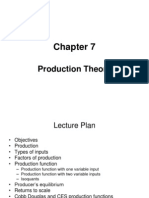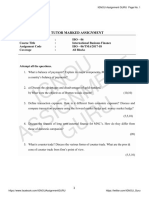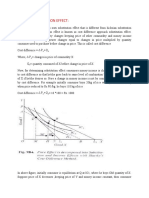Revenue Concepts
Revenue Concepts
Uploaded by
jjjjkjhkhjkhjkjkCopyright:
Available Formats
Revenue Concepts
Revenue Concepts
Uploaded by
jjjjkjhkhjkhjkjkOriginal Description:
Copyright
Available Formats
Share this document
Did you find this document useful?
Is this content inappropriate?
Copyright:
Available Formats
Revenue Concepts
Revenue Concepts
Uploaded by
jjjjkjhkhjkhjkjkCopyright:
Available Formats
1
Concept of Revenue
Treat the customer as an appreciating asset
Revenue is the total amount of money that flows into
the firm.
This can be from any source, including product
sales, government subsidies, venture capital and
personal funds.
Total Revenue:
Total revenue for a firm is the selling price times the
quantity sold.
TR = (P Q)
Where TR: Total Revenue
P: Price
Q: Quantity Sold
2
The total revenue curve can be shown as follows:
If the market demand is linear, the total
revenue curve will be a curve which initially slopes
upward, reaches the maximum point and then starts
declining.
TR
Output
TR
Q
1
3
Average Revenue:
Average revenue tells us how much revenue
a firm receives for the particular unit sold.
Average revenue is total revenue divided by
the quantity sold, which is equal to the price of
the product.
i.e. AR=P
AR = TR/q
Where, AR: Average revenue
TR: Total Revenue
q: quantity sold
4
Marginal Revenue:
Marginal revenue is the increase in the total
revenue received by a firm from selling extra
units of its output.
More specifically, marginal revenue is the
additional revenue that a firm receives from
putting one more unit of output in the market.
The price obviously, is the average revenue
that the seller receives.
The following table indicates how the TR, AR
and MR is calculated:
5
No. of Units
Sold (Q)
Price of the
Product (P)
Total Revenue
(P.Q)
Average
Revenue
(TR/q)
Marginal
Revenue
1 16 16 16 -
2 15 30 15 14
3 14 42 14 12
4 13 52 13 10
5 12 60 12 8
6 11 66 11 6
7 10 70 10 4
8 9 72 9 2
9 8 72 8 0
10 7 70 7 -2
6
Following the above table, the average revenue
and the marginal revenue curves can be derived as
follows
Y
X
O
m
Revenue
Quantity
AR
MR
7
However, in the situation of perfect competition,
where the average revenue or price is constant due
to the market intervention, the marginal revenue
will also be constant.
If the price or average revenue remains the same,
when more and more units are sold, the marginal
revenue will be equal to average revenue.
This is so because when one more unit is sold and
the price does not fall, the addition made to the total
revenue by that unit will be equal to the price at
which it is sold since no loss in revenue is incurred
on the previous units in this case.
This will be better understood by the following table
8
No. of Units Sold
(Q)
Price of the
Product (P) or
Average Revenue
(AR)
Total Revenue
(P.Q)
Marginal Revenue
(MR)
1 16 16 -
2 16 32 16
3 16 48 16
4 16 64 16
5 16 80 16
6 16 96 16
7 16 112 16
8 16 128 16
9 16 144 16
10 16 160 16
9
The case of perfect competition when for an
individual firm average revenue (or price) remains
constant and marginal revenue is equal to average
revenue can be shown by the following diagram:
O
AR & MR
Quantity
AR=MR
P
10
From the diagram it is clear that the average
revenue curve is a horizontal strait line.
Horizontal strait line average revenue curve
indicates that price or average revenue
remains the same at OP level when quantity
sold is increased.
Marginal revenue curve coincides with the
average revenue curve since marginal
revenue is equal to the average revenue.
11
Equilibrium of a Firm:
Equilibrium is a situation which is very essential to the firm.
Any effort to sell at a price higher than the equilibrium price
would be frustrated by the competitors, while no rational firm
like to sell at a price lower than what it could get.
If a firm wants to maximize his profit then first he should
determine its price.
The rational behind the theory is: if the production and sale of
an additional unit of product adds more to revenues than to
costs, profit is increased and thus that unit should be
produced and sold.
If the additional unit of output involves larger costs than
revenues, it should not be produced.
More specifically, the firm continues to increase output until
the marginal revenue is larger than the marginal cost.
Therefore, a firm will be in equilibrium, when:
MR=MC
You might also like
- Unit 3 - Receivable ManagementDocument18 pagesUnit 3 - Receivable Managementharish50% (2)
- Great - Volatility and Correlation in The Pricing of Equity, FX, and Interest-Rate Options (Wiley, 2005) 2Document362 pagesGreat - Volatility and Correlation in The Pricing of Equity, FX, and Interest-Rate Options (Wiley, 2005) 2Kelvin LeungNo ratings yet
- Economics - Cost Revenue ProfitDocument98 pagesEconomics - Cost Revenue ProfitMinnie Titipunya67% (3)
- Financial Ratio AnalysisDocument4 pagesFinancial Ratio Analysisapi-299265916100% (1)
- Capital and RevenueDocument9 pagesCapital and Revenuenazusmani2No ratings yet
- Micro CH-7 RevenueDocument8 pagesMicro CH-7 RevenueLalitKukrejaNo ratings yet
- Market Structure-Perfect CompetitionDocument72 pagesMarket Structure-Perfect CompetitionUtsav Aarya100% (1)
- Consumer EquilibriumDocument11 pagesConsumer EquilibriumTanya AroraNo ratings yet
- Selling CostsDocument4 pagesSelling CostsDharmaj AnajwalaNo ratings yet
- Ordinal Utility Approach Indifference Curves AnalysisDocument34 pagesOrdinal Utility Approach Indifference Curves AnalysisAhesha IndranandaNo ratings yet
- ProductionDocument26 pagesProductionHarsh Dehariya100% (1)
- Ignou AssignmentDocument8 pagesIgnou AssignmentAman VermaNo ratings yet
- Capital and Revenue ExpenditureDocument31 pagesCapital and Revenue ExpenditureHari Purwadi100% (1)
- Revenue CurvesDocument3 pagesRevenue Curvesashar100% (1)
- Slutsky Substitution EffectDocument2 pagesSlutsky Substitution EffectIsmith Pokhrel100% (1)
- Macro Economics NotesDocument31 pagesMacro Economics NotesSonali_2503No ratings yet
- Law of Variable ProportionDocument13 pagesLaw of Variable ProportionSalvia AhmadNo ratings yet
- Theory of MultiplierDocument9 pagesTheory of MultiplierUday PanditNo ratings yet
- Income Elasticity of DemandDocument2 pagesIncome Elasticity of Demandromina lizette gravamenNo ratings yet
- Equilibrium Under Perfect Competition - Perfectly Competitive MarketDocument8 pagesEquilibrium Under Perfect Competition - Perfectly Competitive MarketShital ShastriNo ratings yet
- Revenue: Concepts: Kamal Vatsa Mob: 9650100453Document7 pagesRevenue: Concepts: Kamal Vatsa Mob: 9650100453Manya NagpalNo ratings yet
- Revenue Per Employee Excel TemplateDocument7 pagesRevenue Per Employee Excel TemplateMustafa Ricky Pramana SeNo ratings yet
- Lec 3 - AssumptionsDocument13 pagesLec 3 - AssumptionsPriyadharshan BobbyNo ratings yet
- Ordinal ApproachDocument39 pagesOrdinal ApproachStephan Mpundu (T4 enick)100% (1)
- Revenue AnalysisDocument15 pagesRevenue AnalysisMirabel VidalNo ratings yet
- Price Elasticity of DemandDocument5 pagesPrice Elasticity of Demandalien888No ratings yet
- Pricing & Output DecisionDocument22 pagesPricing & Output DecisionJeremiah Edison Caraga Nicart, CPANo ratings yet
- Cost Concepts in EconomicsDocument15 pagesCost Concepts in EconomicsHarsha mattaNo ratings yet
- IrsDocument12 pagesIrsabinashnayak1No ratings yet
- Ii B.com - 3 Sem-Cost-TheoryDocument19 pagesIi B.com - 3 Sem-Cost-TheoryAR Ananth Rohith BhatNo ratings yet
- Revenue StreamsDocument43 pagesRevenue StreamsAlbert Sanada Yapri100% (1)
- Optimal Combination of ResourcesDocument7 pagesOptimal Combination of ResourcesFajar AmelNo ratings yet
- Optimum Combination of InputsDocument4 pagesOptimum Combination of InputsRhea Joy L. SevillaNo ratings yet
- Nature of Managerial EconomicsDocument10 pagesNature of Managerial EconomicsSonia LawsonNo ratings yet
- Law of Diminishing Marginal UtilityDocument24 pagesLaw of Diminishing Marginal Utilitykingsley100% (1)
- Utility AnalysisDocument15 pagesUtility AnalysisRahul RamchandaniNo ratings yet
- Law of DemandDocument11 pagesLaw of Demandmadesstman88% (8)
- CH 8 Financial EthicsDocument21 pagesCH 8 Financial EthicsMadhu Gupta100% (1)
- 2 Non-Tax Sources of RevenueDocument15 pages2 Non-Tax Sources of RevenueTushar PatilNo ratings yet
- Classical TheoryDocument20 pagesClassical TheoryDeepali Singhai JainNo ratings yet
- Quantity Theory of Money (Fisher)Document3 pagesQuantity Theory of Money (Fisher)Shahrat Farsim Chowdhury100% (1)
- Concepts of Cost & Various Types of Cost: UNIT-4Document22 pagesConcepts of Cost & Various Types of Cost: UNIT-4srijan consultancyNo ratings yet
- Capital and RevenueDocument21 pagesCapital and RevenueVishal BhardwajNo ratings yet
- Theory of Production 1 0Document22 pagesTheory of Production 1 0Suthan Dinho సుతాన్ దళినైడుNo ratings yet
- Essay On Consumer's Equilibrium - EconomicsDocument15 pagesEssay On Consumer's Equilibrium - EconomicsUsman KhanNo ratings yet
- Ms.K.GOWRI, Associate Professor in Management Studies, Excel Business SchoolDocument82 pagesMs.K.GOWRI, Associate Professor in Management Studies, Excel Business Schoolvishwavichu100% (1)
- Security Valuation: Meaning and FactorsDocument7 pagesSecurity Valuation: Meaning and FactorsRohit BajpaiNo ratings yet
- Ridge LinesDocument42 pagesRidge LinesManik Kamboj100% (1)
- 3.3. Law of Returns To ScaleDocument12 pages3.3. Law of Returns To ScaleShivam Singh Thakur100% (1)
- Cost & Cost CurvesDocument46 pagesCost & Cost CurvesManoj Kumar SunuwarNo ratings yet
- Corporate Reporting:: Definition and EvolutionDocument5 pagesCorporate Reporting:: Definition and Evolutionfaisal gaziNo ratings yet
- Economies of Large Scale ProductionDocument14 pagesEconomies of Large Scale ProductionPrabhkeert Malhotra100% (2)
- Trade CycleDocument8 pagesTrade CyclestunningvibhaNo ratings yet
- Bba Chapter 4 Pricing Under Various Market ConditionsDocument21 pagesBba Chapter 4 Pricing Under Various Market ConditionsDr-Abu Hasan Sonai SheikhNo ratings yet
- Revenue Types: Total, Average and Marginal Revenue!Document7 pagesRevenue Types: Total, Average and Marginal Revenue!Nasir KhanNo ratings yet
- Price Determination Under Diff. MarketsDocument25 pagesPrice Determination Under Diff. Marketsvishu2710kNo ratings yet
- 2nd PU CHAPTER 4 The Theory Under Perfect CompitionDocument13 pages2nd PU CHAPTER 4 The Theory Under Perfect Compitionjasitharrya75No ratings yet
- 4.1 P C: D F: Erfect Ompetition Efining EaturesDocument18 pages4.1 P C: D F: Erfect Ompetition Efining EaturesIlias AhmedNo ratings yet
- Leec 204Document18 pagesLeec 204YCS IS LIVENo ratings yet
- Week 7 - Revenue and ProfitDocument28 pagesWeek 7 - Revenue and ProfitAdruffNo ratings yet
- Leec 204Document18 pagesLeec 204surjeetkumari1974No ratings yet
- 4 The Theory of The Firm Under Perfect CompetitionDocument8 pages4 The Theory of The Firm Under Perfect CompetitionKuldip Singh ChhikaraNo ratings yet
- Accounting, Maths and Computing Principles for Business Studies Teachers Pack V11From EverandAccounting, Maths and Computing Principles for Business Studies Teachers Pack V11No ratings yet
- Law of Variable ProportionsDocument26 pagesLaw of Variable Proportionsjjjjkjhkhjkhjkjk100% (1)
- Correlation AnalysisDocument51 pagesCorrelation Analysisjjjjkjhkhjkhjkjk100% (1)
- Regression AnalysisDocument21 pagesRegression AnalysisjjjjkjhkhjkhjkjkNo ratings yet
- Job Analysis: Dr. Rinku Sanjeev Faculty-HRDocument30 pagesJob Analysis: Dr. Rinku Sanjeev Faculty-HRjjjjkjhkhjkhjkjkNo ratings yet
- Unit 12Document2 pagesUnit 12Ângela Dominicci SatoNo ratings yet
- 0452/22/F/M/22 © Ucles 2022Document1 page0452/22/F/M/22 © Ucles 2022XinYi ChenNo ratings yet
- ManjulaDocument10 pagesManjulaShilpa RNo ratings yet
- Distribution ManagementDocument16 pagesDistribution ManagementAdil WaqarNo ratings yet
- 2016 Informed Short Selling, Fails-To-Deliver, and Abnormal ReturnsDocument22 pages2016 Informed Short Selling, Fails-To-Deliver, and Abnormal ReturnsGMTplus1100% (1)
- Avoiding Common Pitfalls in Auditing Internal Controls 1Document50 pagesAvoiding Common Pitfalls in Auditing Internal Controls 1Ning JiaNo ratings yet
- Pt. Aming Skedul Penagihan Piutang Januari - April 2011: Harga Pokok PenjualanDocument8 pagesPt. Aming Skedul Penagihan Piutang Januari - April 2011: Harga Pokok PenjualanPiranda AgnilNo ratings yet
- Queen's Walk Investment Ltd. 170810 ProspectusDocument152 pagesQueen's Walk Investment Ltd. 170810 ProspectusFiachra O'DriscollNo ratings yet
- Theories of FirmDocument30 pagesTheories of FirmAnup kattelNo ratings yet
- أهمية نظام الإنتاج في الوقت المحددDocument29 pagesأهمية نظام الإنتاج في الوقت المحددBadis BougheddaNo ratings yet
- Advanced Strategic ManagementDocument110 pagesAdvanced Strategic ManagementDr Rushen SinghNo ratings yet
- Ashmeet Singh EIMEDocument7 pagesAshmeet Singh EIMEhanishgurnani 2k20umba12No ratings yet
- Chapter-3 Specialisation-1 HRMDocument14 pagesChapter-3 Specialisation-1 HRMRahul ThakurNo ratings yet
- Supply & Demand 10Document8 pagesSupply & Demand 10zakria100100No ratings yet
- Behavioral FinanceDocument13 pagesBehavioral FinanceSimmi Khurana100% (2)
- SAP FI Enterprise Structure & GLDocument8 pagesSAP FI Enterprise Structure & GLRahul ShelarNo ratings yet
- Greeners FR6 PR 013Document1 pageGreeners FR6 PR 013jeremie carpioNo ratings yet
- Service Quality Model AuditDocument3 pagesService Quality Model Audityashvimehta93No ratings yet
- SCM NotesDocument46 pagesSCM NotesKaran Umralkar50% (6)
- Finance Project Report On Commodity MarketDocument67 pagesFinance Project Report On Commodity MarketSaket VermaNo ratings yet
- Nissan Edition 9 Lesson SuggestionsDocument4 pagesNissan Edition 9 Lesson SuggestionsMetchie NavarroNo ratings yet
- Overall Cost Leadership StrategyDocument8 pagesOverall Cost Leadership StrategysachinNo ratings yet
- Business English 1: School of Business & Social SciencesDocument9 pagesBusiness English 1: School of Business & Social SciencesdanielalmuNo ratings yet
- Comparison of Financial Accounting and Management AccountingDocument4 pagesComparison of Financial Accounting and Management AccountingBeng-bereng Beng-bengNo ratings yet
- Ed Onerous Contracts Factsheet Dec 2018Document4 pagesEd Onerous Contracts Factsheet Dec 2018Micaah marie AlbinoNo ratings yet
- Ba 194 Final Paper On Universal Robina CorpDocument4 pagesBa 194 Final Paper On Universal Robina CorpWakei MadambaNo ratings yet
- How Many Types of Business Model Are There in The World? Make Them ClearDocument4 pagesHow Many Types of Business Model Are There in The World? Make Them ClearHải Yến NguyễnNo ratings yet





























































































